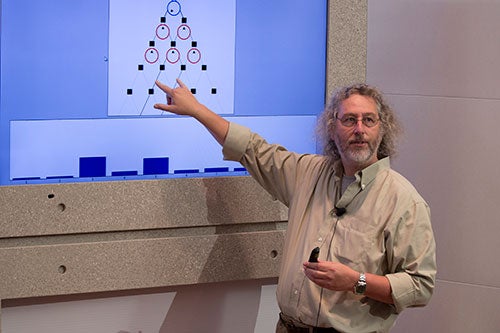
How to build a quantum computer
Waterloo researcher David Cory shares three rules for building a quantum computer

Waterloo researcher David Cory shares three rules for building a quantum computer
By Janet Janes Office of Research
Building a quantum computer can be accomplished by following three simple rules — yet it’s viewed by many as the pinnacle of scientific endeavour.
“Quantum mechanics is the foundation of everything we can do in the world. So if we can build a device that is uniquely quantum mechanical … we’ve reached the ultimate efficiencies that nature allows us. There are things that we can do in the quantum world that we can’t do in the classical world,” said Canada Excellence Research Chair David Cory. He was speaking at Research Talks, the first in a series of on-campus sessions featuring University of Waterloo researchers.
Cory, deputy director of Waterloo’s Institute for Quantum Computing, shared his quest to build the first 100 qubit universal quantum computer with about 200 students, staff, and faculty members. During the lecture he outlined three basic rules.
Since quantum mechanics is outside of everyday experiences it’s not only different, it’s also more powerful, he told the audience. The key to making something quantum mechanical is to ensure the environment doesn’t know it was there. Therefore, the first rule involves keeping information hidden from all the corruption in a classical environment.
The next step is engineering the system. A laptop computer can simulate about 20 qubits. The largest computer in the world, the MilkyWay-2 located in China, about 35 qubits. Given these restrictions, rule number two is to keep the parts needed for modelling small because it’s not possible to model anything that’s big.
“Even if they gave you the MilkyWay-2 you wouldn’t be able to do it, and of course no one is going to give you the universe,” he said.
Most people who are trying to build a quantum computer are doing so using an array of inter-connected nodes so that there are small processors that can be simulated, controlled, and engineered – with the quantum interconnects between them making one big processor.
Finally, the third rule is to cool the quantum computer – a rule that still needs to be written. Cooling removes accumulated noise keeping computations reliable.
“We actually, in fact, don’t know how to cool our computer,” said Cory. “We’ll never solve this problem on a classical computer. People have tried for a long time.”
As is common with progress, tools are built to solve problems and with new problems come new tools. The solution?
“We need to take that problem and run it on a quantum computer,” says Cory. “We need to get beyond the classical threshold – and 100 is a good next step. If we can get there, there’s an awful lot we can do.”

Read more
Here are the people and events behind some of this year’s most compelling Waterloo stories

Read more
Meet the five exceptional graduate students taking the convocation stage as Class of 2024 valedictorians

Read more
Velocity Pitch Competition winners share exciting startup ideas using artificial intelligence and deep tech, showcasing creativity and entrepreneurial prowess
The University of Waterloo acknowledges that much of our work takes place on the traditional territory of the Neutral, Anishinaabeg, and Haudenosaunee peoples. Our main campus is situated on the Haldimand Tract, the land granted to the Six Nations that includes six miles on each side of the Grand River. Our active work toward reconciliation takes place across our campuses through research, learning, teaching, and community building, and is co-ordinated within the Office of Indigenous Relations.